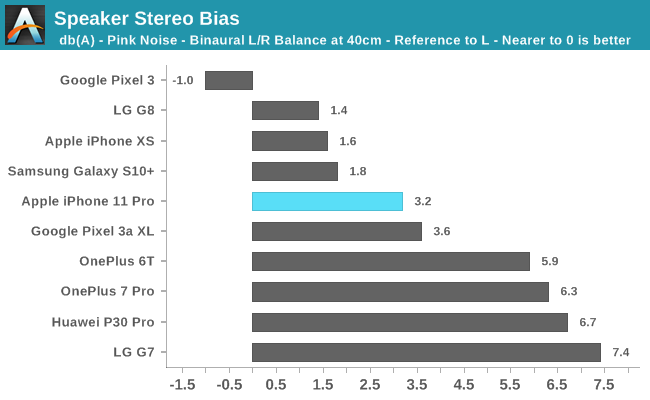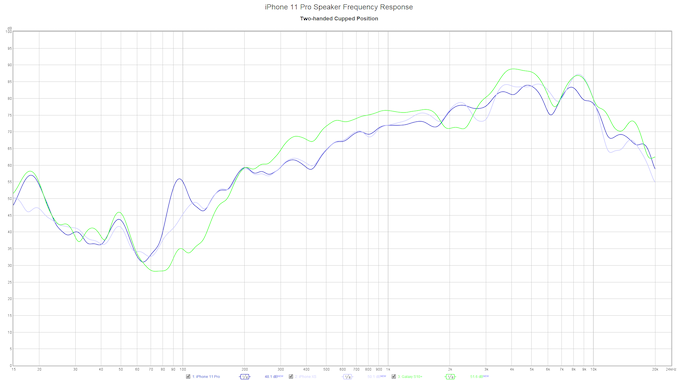The Apple iPhone 11, 11 Pro & 11 Pro Max Review: Performance, Battery, & Camera Elevated
by Andrei Frumusanu on October 16, 2019 8:30 AM ESTVideo Recording
Video recording on the iPhone is known to be extraordinarily good in terms of quality. The iPhone 11 series is said to improve in this regard thanks to an improved HDR with more dynamic range (though Apple still stores video in SDR format). Naturally of course what’s also exciting is that we’re now able to capture video with a wide-angle lens, and seeing a lot more content of a given scene.
Apple has improved the EIS this generation, and it now results in a much smoother video capture experience than the past iterations. When you have with a lot of detail in a scene though, you can sometimes see the jitter caused by the OIS and EIS interacting with each other.
In the wide-angle recording, the EIS was a bit haphazard. In the first part of the video walking down the path it doesn’t look to be stabilizing much at all, when I turn left to the second path suddenly the EIS kicked in and things were a lot less shaky, and it then again loses the stabilization for few steps until it finally resumes again. This happened all three recordings with the wide-angle camera, and I don’t know it was me holding the phone any different between those two paths.
The quality and detail of the videos are all great. The one thing noticed though is that there’s the occasional exposure flicker in some areas. In effect Apple here is doing two exposures per frame and combining them together like Smart HDR – we can notice that in parts of the scene, and most visible the sky is flickering or pulsing in brightness.
The handling between the three camera sensors is very good, it’s particularly fast and seamless to switch between the main and wide-angle modules, while there’s a small delay to switch to the telephoto module. Switching between the three modules is only possible in 30fps recording modes; it’s still possible to record 60fps in any of the three modules but you have to start out the video with the camera that you want to use, and you’ll be limited to digital zooming only while recording.
Speaker Evaluation
In terms of audio for the iPhone 11 series, Apple’s big addition is the inclusion of Dolby Atmos. Naturally you have to watch multi-channel audio content to be able to take advantage of the feature. For regular stereo audio playback, we investigate if Apple has done any changes to the speaker setup and if it differs to that of the XS.

In terms of audio volume, the iPhone 11 Pro is ever so slightly quieter when being held in portrait mode. The bigger difference that’s definitely more audible is when holding the phone in landscape mode with both hands and the palms cupped – the usual way one would hold a phone in landscape. Here it’s 3dB quieter than the iPhone XS, which is a noticeable amount.

Investigating the phone’s stereo bias thanks to a binaural microphone setup, we see that that things have notably regressed for the iPhone 11 Pro when compared to the XS. It’s relatively normal for the main speaker (Right side) to appear louder, however it’s extremely weird that it’s now 1.6dB more biased than on the iPhone XS. Indeed when comparing the 11 Pro and XS side-by-side, and muting the main speaker by holding a finger on it, volume being equal and otherwise calibrated between the two phones, it’s immediately audible that the 11 Pro earpiece speaker is much quieter compared to what we experience on the XS.
This has a rather large knock-on effect on the spatial sound reproduction of the 11 Pro as it just isn’t able to fill up the surrounding area quite as well as on the XS.
Looking at the frequency response between the 11 Pro and the XS, we see that things are extremely similar up to the high mid-ranges, with a more noticeable peak at 95Hz for the 11 Pro. Towards the treble we see some more deviations, it’s here that the 11 Pro is a bit quieter and I think that’s due to the weaker earpiece speaker.
Overall, the sound signature of the iPhone 11 Pro hasn’t changed all too much, and it is actually more of a downgrade in audio playback due to the weaker earpiece speaker calibration. The Galaxy S10’s notably stronger lower mid-range and mid-range still make for a much superior audio playback and is in my experience the device to beat in terms of speaker quality.











242 Comments
View All Comments
joms_us - Wednesday, October 16, 2019 - link
Try 4.4Ghz Core2Duo E8600 and Ryzen 3600x in SuperPI 1M.You will see E8600 is faster by 2 secs, makes you wonder?
Released in 1995, 13-15 years difference between two processors. E8600 is faster? LOL
This SPEC need serious overhauling, same as GB that is tuned to Apple SoC. Apple A13 faster than 5GHZ Intel or Ryzen in GB5? LOL, people are seriously retarded nowadays...
thunng8 - Wednesday, October 16, 2019 - link
What has superPI got to do with spec2006? Spec2006 is a well respected desktop/workstation benchmark that tests many different algirthms and use case while superPI does 1 specific narrow test.As a real world example, I've found my ipad pro 2018 exports RAW files from Adobe lightroom faster than my 2018 6 core mac mini (i7-8700) and a lot faster than my 2017 13" (2xi5) macbook pro (almost 2x faster).
Laptopmag also had similar findings. https://www.laptopmag.com/reviews/laptops/new-ipad...
Quantumz0d - Thursday, October 17, 2019 - link
Do you know that Apple pays Adobe for First Party Optimization ? GB also is not an indicative performance.thunng8 - Thursday, October 17, 2019 - link
So Adobe Lightroom is optimized for Apple and not their largest platform and money earner which has lots of competitors? That’s the silliest comment I’ve seen yet.WinterCharm - Thursday, October 17, 2019 - link
People aren’t ready to believe it because of their PC / X86 bias.The writing is on the wall. Objective measurements show that Arm has caught up, and half the people in these comments are making excuses or saying “nuh uh because it doesn’t run Linux”
id4andrei - Thursday, October 17, 2019 - link
Hey joms, spec is an efficiency benchmark. A 5w CPU does not beat an actively cooled 65w one from AMD or Intel. At least in SPECint Apple matches desktop CPUs. That's how you interpret.Give credit to Apple and move on.
joms_us - Thursday, October 17, 2019 - link
Problem is, graph is a huge mess, not normalized. For e.g A13 maybe doing 60+ in perf but consuming 5w whereas SD850 is doing 30 perf in a mere 2w. Which one is better?id4andrei - Thursday, October 17, 2019 - link
From an overall performance standpoint obviously A13. From an efficiency standpoint the 855 equalled the A12. Both are slightly more efficient than A13 from a peak power perspective. In real life, with average workloads, A13 is overall more efficient than both.Apple invests a lot in their chips and sets the pace. Come February next year it's up to Qualcomm to narrow the gap.
joms_us - Thursday, October 17, 2019 - link
There you go, efficiency is the key and A13 is not as efficient as you said. Now in realworld comparison, the likes of Note 10 and OP7T are far better and or bang for the buck. Those long perf graphs are really misleading.. time to fix them.id4andrei - Friday, October 18, 2019 - link
I'm an android user and nothing here is misleading. The A13 is the best SoC.One thing to understand is that the iphone here is deliberately actively cooled so that it removes all thermal restraints and show the chip's full capabilities. In real life it would throttle.